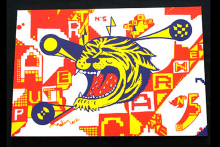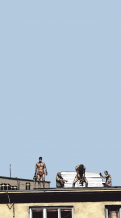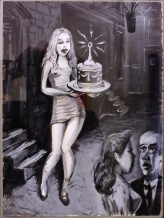| Umělec 1997/4 >> Art Attacked | Просмотр всех номеров | ||||||||||||
|
|||||||||||||
Art AttackedUmělec 1997/401.04.1997 Tomáš Lahoda | new media | en cs |
|||||||||||||
|
It appears that not only dadaist and modernist positions in general were doing things head on as similar tendencies now emerge in contemporary art. On May 9, 1994, an unknown artist Mark Bridger attacked the work of well-known Damien Hirst in Serpentine Gallery where he was exhibiting his glass containers with bodies of animals cut in half and soaked in formaldehyde. Bridger later described the moment of spilling uncertain volume of ink into the tank as a moment of pure inspiration. He completely destroyed Hirst’s Away From the Flock that way but at the same time created a new piece called Black Sheep by Mark Bridger. Bridger wasn’t in opposition to Hirst’s work, on the contrary he was hoping that Hirst would accept his intervetion as it was based on the same art category as Hirst’s work. His act therefore was not iconoclasm but a dialogue, a statement and an artistic gesture which parasites on another work of art yet at the same time pays certain tribute to it. Damien Hirst himself was a parasite on certain kind of abstract painting in his „point paintings“. As opposed to creating something completely new and original (modernism), the artist-hooligan uses aggressive dialogue with already existing text (post-modernism). Criticism of an institution, deconstruction, citation and appropriation combined with unobscured love and respect to art stands behind motivation of such acts from recent history. For example, well-known and successful New York gallerist Tony Shafrazi attacked Picasso’s Guernica shown at the Museum of Modern Art in 1974 spraying Kill Lies All in red letters on it. He then said about his act: „I wanted to bring art closer to presence, liberate it from art history and give it life.“
And how did Mark Bridger end up in the end? Unfortunately, it turned out that Hirst was not so tolerant as Bridger had hoped for. Away From the Flock was restored to its original appearance and Bridger was sentenced to two years on probation. Didn’t Bridger have the right to accuse Hirst of destroying his Black Sheep then? Most recently, Russian artist Oleg Kulik crawls naked on all four with a chain attached to his neck like a dog in personally defined territory marked by a sign „Danger“. At one point he literally gets off the leash and bites one of the viewers watching his act as the viewer got too close. In this project entitled Dog House, Kulik refused human speech and communication as a process which is either unfruitful or aggressive. In February this year, another Russian artist Alexander Brener was called to court in Amsterdam for his artistic act. On January 4, 1997, he sprayed a green dollar sign on Kazimir Malevich’s White Cross On White Background. He was sentenced to ten moths with five month probation and he has to pay 15.000 Dutch guilders. A group of ten young Danish artists were exhibiting under a group name L.E.F.K.T.D.K. (Life is too short for Danish art) in Christian Dam Gallery in Copenhagen in March. The concept of the exbition was based on destruction of art works made by other artists who were asked to donate their pieces for destruction. Piles of the remains were then exhibited as a new collective work of art. The Letter of Support This is a letter of support for Alexander Brener, an artist who has to stand in front of Dutch court on charges of vagabondage and destruction of the Malevich painting White Suprematism 1922 - 1927. We met Alexander in 1994 in Moscow where he was known as a poet of controversial Russian-Jewish identity. When we met with him, he had just re-emigrated from Israel where he left with his family a few years before. He explained his return to Moscow as a gesture of his disillusionment with any existing political system, finding Russia after the collaps of socialism an appropriate place to make an artistic statement of this disillusionment. Our common language - which resulted in a few joint projects, including Interpol and Transnacionala in 1996 - is based on the belief that the contemporary art situation is highly politicized in the sense that economically stronger countries control and abuse the system of values we inherited from the tradition of contemporary art of this century as a common spiritual good. It is therefore necessary and legitimate for any artist to question the position and mechanisms of implementation of an individual art work in a system of art which refuses to be just a toy of markets and ideologies. To satisfy this necessity, Brener transposed his poetic statement from literature to the direct physical language of actions-performances. At the beginning of 1994, he did an action in the Fine Art Museum (Pushkinskij Musei) in Moscow where he stood in front of one of van Gogh’s paintings and excremented in his pants while repeating: „Vincent, Vincent“. He described this action as a dialogue with the beginnings of modernism where „excrement in pants“ had a double meaning - both of great pleasure caused by the work of art and the notion of excrement as a symbolic materialization of the monolithic ideology that van Gogh was placed in as its founder... As Alexander stated during his visit in Ljubljana (in October, 1995), he doesn’t believe in a political democracy but he does believe in a democratic art - that is, an art of individuality fighting for mental and spiritual freedom and moral progress. Political democracy is impossible because it demands total responsibility of every member of the society. Therefore, art is a good tool which should be used for democratic self-development. For Brener, the majority of Russian art is not democratic because it derives from a very narrow circle of Russian intelligentsia. There are some exceptions such as Tolstoy, Mayakovsky and Khlebnikov. He distinguishes avant-garde art from modernism by the difference in their impact. Avant-garde art has an ethical impact which is completely different from the formal impact of modernism... For Brener, the avant-garde artist is a man who is able to pledge all his being against Western civilization. As Western civilization is a violent appropriation of all other worlds, for him the language of affect (as defined by Antonin Artaud) is the only weapon against the unquestionable power of Western societies. In his actions, he articulates this language of emotions through three basic feelings and principles: sexuality, aggression and impotency. We described some previous works and actions, together with Brener’s philosophical and ethical position in relation to the question of art, in order to prove that his latest action - in which he sprayed green paint in the shape of a dollar sign on the Malevich painting White Suprematism 1922 - 1927, a white cross on a white background - is an act of consistent artistic language of expression and therefore cannot be interpreted as an act of a lunatic or a criminal act... We believe that Alexander Brener didn’t destroy anything that Kazimir Malevich contributed to mankind. On the contrary, he artistically enlightened the misunderstood as to what Malevich actually contributed to humanity by reflecting the act of reification where so-called cultural world is showing respect to his dead object while at the same time disrespect to the genuine, living culture he comes from. The force behind this misunderstanding is symbolized in the sign he sprayed over the work. ... Eda Cufer, Ljubljana, February 11, 1997 Goran Dordevic IRWIN: Dusan Mandic, Miran Mohar, Andrej Savski, Roman Uranjek, Borut Vogelnik (Full text is available at URL http://www.heck.com/nsk/nsksupport.html) (pages15 through 19)
01.04.1997
Рекомендуемые статьи
|
|||||||||||||
|
04.02.2020 10:17
Letošní 50. ročník Art Basel přilákal celkem 93 000 návštěvníků a sběratelů z 80 zemí světa. 290 prémiových galerií představilo umělecká díla od počátku 20. století až po současnost. Hlavní sektor přehlídky, tradičně v prvním patře výstavního prostoru, představil 232 předních galerií z celého světa nabízející umění nejvyšší kvality. Veletrh ukázal vzestupný trend prodeje prostřednictvím galerií jak soukromým sbírkám, tak i institucím. Kromě hlavního veletrhu stály za návštěvu i ty přidružené: Volta, Liste a Photo Basel, k tomu doprovodné programy a výstavy v místních institucích, které kvalitou daleko přesahují hranice města tj. Kunsthalle Basel, Kunstmuseum, Tinguely muzeum nebo Fondation Beyeler.
|




































 We Are Rising National Gallery For You! Go to Kyjov by Krásná Lípa no.37.
We Are Rising National Gallery For You! Go to Kyjov by Krásná Lípa no.37.
Комментарии
Статья не была прокомментированаДобавить новый комментарий